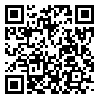Volume 72, Issue 4 (July 2014)
Tehran Univ Med J 2014, 72(4): 229-234 |
Back to browse issues page
Download citation:
BibTeX | RIS | EndNote | Medlars | ProCite | Reference Manager | RefWorks
Send citation to:



BibTeX | RIS | EndNote | Medlars | ProCite | Reference Manager | RefWorks
Send citation to:
Mehrafza M, Raoufi A, Rahimian T, Abdollahian P, Nikpouri Z, Tavakkolnia R, et al . Comparison of intracytoplasmic sperm injection outcome of oligoasthenoteratozoospermic and azoospermic men. Tehran Univ Med J 2014; 72 (4) :229-234
URL: http://tumj.tums.ac.ir/article-1-6074-en.html
URL: http://tumj.tums.ac.ir/article-1-6074-en.html
Marzieh Mehrafza * 
 1, Azadeh Raoufi
1, Azadeh Raoufi 
 , Talieh Rahimian
, Talieh Rahimian 
 , Parvaneh Abdollahian
, Parvaneh Abdollahian 
 , Zahra Nikpouri
, Zahra Nikpouri 
 , Rahim Tavakkolnia
, Rahim Tavakkolnia 
 , Abolfazl Golmohammadi
, Abolfazl Golmohammadi 
 , Ahmad Hosseini2
, Ahmad Hosseini2 


 1, Azadeh Raoufi
1, Azadeh Raoufi 
 , Talieh Rahimian
, Talieh Rahimian 
 , Parvaneh Abdollahian
, Parvaneh Abdollahian 
 , Zahra Nikpouri
, Zahra Nikpouri 
 , Rahim Tavakkolnia
, Rahim Tavakkolnia 
 , Abolfazl Golmohammadi
, Abolfazl Golmohammadi 
 , Ahmad Hosseini2
, Ahmad Hosseini2 

1- , dr.mehrafza@yahoo.com
2- rsity of Medical Sciences, Tehran, Iran.
2- rsity of Medical Sciences, Tehran, Iran.
Abstract: (6005 Views)
Background: With introduction of intracytoplasmic sperm injection with testicular sperm extraction or precutaneouse epididymal sperm aspiration, effective treatment was provided for azoospermic men. The aim of present study was to compare clinical outcome following intracytoplasmic sperm injection using extracted testicular/epididymal sperm or ejaculated severe oligoasthenoteratozoospermic sperm.
Methods: After retrospective evaluation of more than four hundred medical records of patients undergoing intracytoplasmic sperm injection Mehr medical institute (between 2011-2012), 45 cycles with severe eligoasthenoteratozoospermia and 34 cycles with azoospermia were included. Patients were treated with gonadotropin releasing hormone agonist. The clinical characteristics and intracytoplasmic sperm injection outcome such as the rate of fertilization, implantation and clinical pregnancy were compared between the two groups. Results were presented as mean±standard deviation and number (percent). Differences between variables were analyzed using student's t test and the chi-square test was used to examine differences between categorical variables. P value less than 0.05 were considered as statistically significant.
Results: Mean of female age (29±4.9 vs. 30.2±5.8), body mass index (26.9±5.3 vs. 26.9±3.8), estradiol level on human chorionic gonadotropin administration day (1375.6±843.9 vs. 1181.8±673.1), total number of retrieved oocytes (9.7±5.3 vs. 9.2±5.9) and metaphase II oocytes (7.7±5.1 vs. 7.5±5.4) were similar between the two groups. Of 436 and 313 retrieved oocytes, respectively 232 and 163 oocytes were ferti-lized in oligoasthenoteratozoospermic and azoospermic groups (53.2% vs. 52.1%, P=0.214). There were not statistical differences between groups in number of trans-ferred top quality embryos (1.5±1.2 vs. 1±1.2, P=0.09), implantation rate (22.7% vs. 16.9%, P=0.238) and clinical pregnancy rate (21 (47.7%) vs. 11 (35.4%), P=0.199).
Conclusion: Intracytoplasmic sperm injection with precutaneouse epididymal sperm aspiration and testicular sperm extraction are effective methods to treat azoospermic men and its clinical outcome were comparable to ejaculated sever oligoasthenoterato-zoospermic cycles. It can be concluded that the influence of sperm quality and origin on intracytoplasmic sperm injection outcome are the same.
Type of Study: Original Article |
Send email to the article author
| Rights and permissions | |
 |
This work is licensed under a Creative Commons Attribution-NonCommercial 4.0 International License. |



